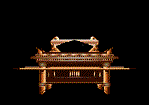Ark of the Covenant is described in the Hebrew Bible as a sacred container, wherein rested the stone tablets containing the Ten Commandments. The Ark was built at the command of God, in accord with Moses's prophetic vision on Mount Sinai (Exodus 25:9-10). Its primary function was for God to communicate with Moses, "from between the two cherubim" on the Ark's cover (Exodus 25:22). The Ark and its sanctuary were "the beauty of Israel" (Lamentations 2:1). Rashi and some Midrashim suggest that there were two arks - a temporary one made by Moses and a later one made by Bezalel (Hertz 1936).
During the journeys of the Israelites, the Ark was carried by the priests in advance of the host (Numbers 4:5, 6; 10:33-36; Psalms 68:1; 132:8). The Ark was borne by priests into the bed of the Jordan, which separated, opening a pathway for the whole of the host to pass over (Joshua 3:15, 16; 4:7, 10, 11, 17, 18). The Ark was moreover borne in the procession round Jericho (Josh. 6:4, 6, 8, 11, 12). When carried, the Ark was always wrapped in a veil, in badger skins, a blue cloth, and was carefully concealed, even from the eyes of the Levites who carried it.
Palkhi
In the year 1685, Narayan baba, the youngest son of Tukaram was a man of innovative spirit and decided to bring about a change in the dindi-wari tradition by introducing the Palkhi, which is a sign of social respect. He put the silver padukas (footsteps) of Tukaram in the Palkhi and proceeded with his dindi to Alandi where he put the padukas of Dnyaneshwar in the same Palkhi. This tradition of twin Palkhis went on every year, but in 1830 there were some disputes in the family of Tukaram, concerned with rights and privileges. Following this, some thoughtful persons decided to break-up the tradition of twin Palkhis and organise here after, two separate Palkhis - Tukaram Palkhi from Dehu and the Dnyaneshwar Palkhi from Alandi. Palkhi. This tradition of twin Palkhis went on every year, but in 1830 there were some disputes in the family of Tukaram, concerned with rights and privileges. Following this, some thoughtful persons decided to break-up the tradition of twin Palkhis and organise here after, two separate Palkhis - Tukaram Palkhi from Dehu and the Dnyaneshwar Palkhi from Alandi. |
|
| From that time till date, both the Palkhis meet in Pune for a brief halt and then diverge at Hadapsar to meet again at Wakhri, a village nearby to Pandharpur. |
|
| Along with times, the popularity of this ancient tradition has soared immensely. A total of approximately 1.5 lakh devotees proceed along with the Sant Tukaram Palkhi from Dehu village, while a total of 2.25 lakh devotees march along with the Sant Dnyaneshwar Palkhi. At present a total of 43 Palkhis including the above two visit Pandharpur every year. |


No comments:
Post a Comment